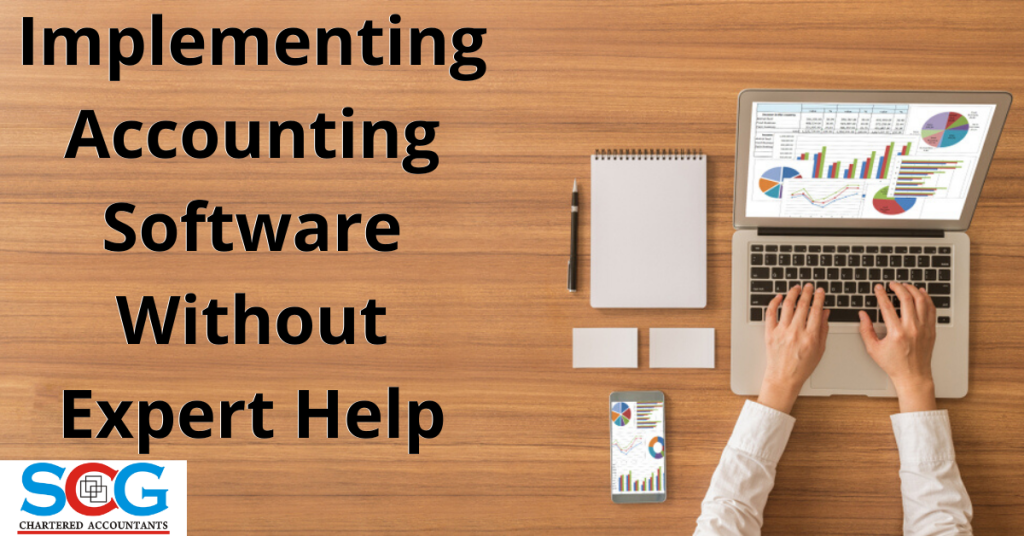Businesses use financial data to judge how they are doing and decide what to do. But accounting is a chore.
So, it is no surprise that more small businesses are using accounting software. We notice that they are implementing the software without expert help. The major reason they give is that expert help is expensive.
There are often problems with such implementations and the business does not get accurate information. In this article, we show you how to improve the outcomes if you implement accounting software without expert help.
Problems with Implementation
The major problem with self-implementation is it goes often goes wrong, and the business does not get reliable financial information because:
- The system set up not right.
- Users misuse the software because of inadequate training.
- The data input is inaccurate.
- Users have poor accounting knowledge – you need reasonable accounting knowledge to implement accounting software.
- The procedures for capturing and processing financial transactions are inadequate.
Stages in Software Implementation
To get a successful outcome, you must take a systematic approach to the project. Use a framework, such as the stages below, to control the implementation:
- Software selection
- Implementation
- User training
- Go live
What should you consider at each stage?
Software Selection
Choosing the right software is the key to success. As you decide on the software to use, consider:
- The financial information people often request.
- Features – examples of feature to consider are:
- Invoices
- Purchase orders
- Inventory management
- Accounts receivable and payable
- Reconciliations
- Reports – Balance Sheet, Profit and Loss and Trial Balance
- Online or on-site options – do you want online software or one you run on site?
Implementation
Now that you have selected the software, you must prepare it to receive and process data. Some of the issues to address are:
- You must create a chart of accounts,.
- Vendor, customer, and inventory numbering.
- Decide on the documents and forms you need.
- Determine on the data you want to bring into the software e.g. opening balance.
- Set up and configure the software.
- Load the data.
You may have to create an implementation plan.
User training
User training is necessary for them to use the software. Train users on the software, making sure they understand how to use the features they need to do their work.
Go Live
- Carry out a parallel run–in a parallel run you input the same data through the existing and the new accounting systems and compare the results. If the existing system is not reliable, then you should check that the output is correct.
- Go live – from now on, use the accounting software.
Way Forward
My suggestions, in order of preference, are:
- Use expert help–you can use expert help for the entire project. If you cannot afford that, I recommend that you use expert help for part of the project e.g. setting up and configuring the software.
- If you cannot afford an expert, then the team doing the project has a lot to do before they start. They must study the application. Some activities they must do are:
- Consult the help you can find–user guides, videos, vendor customer support team and other users of the software.
- Learn how to set up the software and use the features.
- Identify and gather the data they need to set-up the software.
The vendor customer support team is interested in proper usage of their software, so lean on them and use their guidance as much as possible.
- Set up the software, load the data and perform parallel runs.
When the implementation team knows how to set up, configure, and use the software they should:
- Set up the software and configure the various documents e.g. invoices and purchase orders.
- Load the data such as opening balances, customers, and vendor details.
- Train users on the features relevant to them.
- Perform parallel runs for a period. In a parallel run, you run the same transactions through your existing and new software and compare the result.
- Diagnose and rectify problems causing differences.
When diagnosing problems with setup and implementation, do not forget to consult the software vendor support team and the network of other users of the software.
- Go live – when the outcome of the parallel run is acceptable, you can switch to full usage of the software.
Takeaway
If you choose the wrong software, the setup is not right or you do not train users, you will not get excellent results. To get excellent results:
- Use experts who know the software to help with the implementation. This is the preferred option.
- If you do it yourself, make sure you know how to set up and use it. Consult vendor support and their network of other users.
SCG can assist you with your software setup, and training needs. Contact us today to see how we can help you make your business more efficient.
For more blogs and information please follow SCG Chartered Accountants on Facebook, Twitter, Youtube and LinkedIn.

